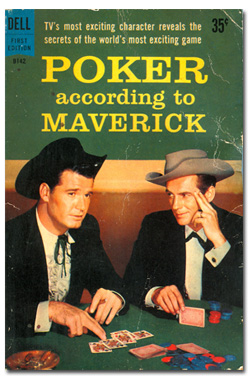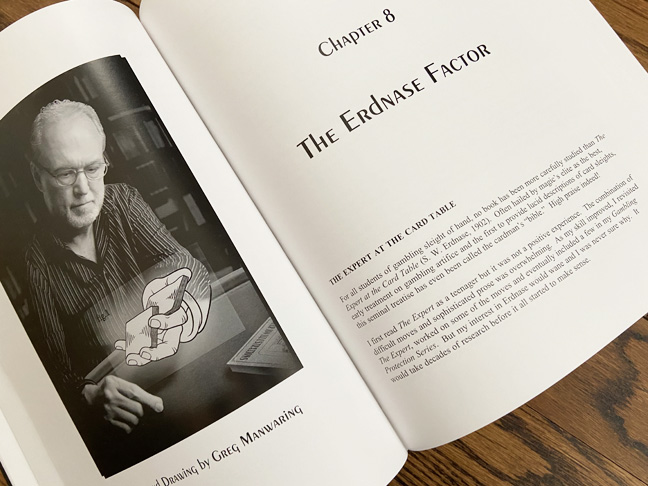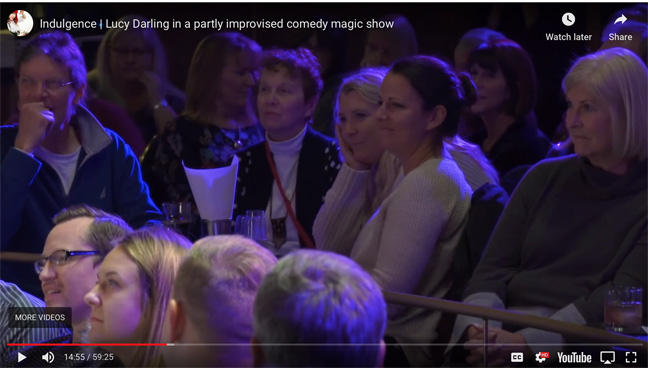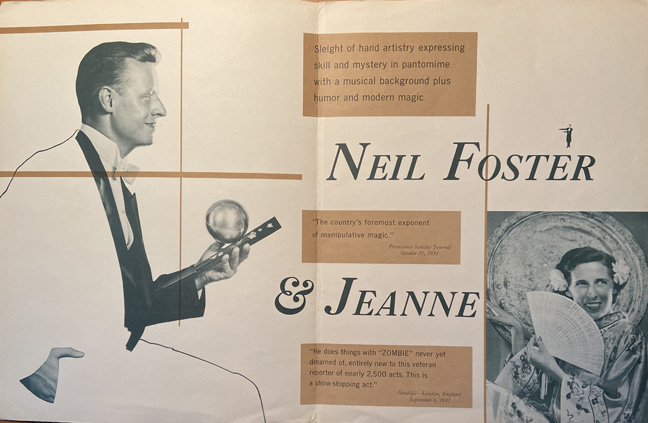
|
Note ye ed's email address: stevebryant99@gmail.com. |


The real deal.
|
Return to our February 2020 issue to stick a voodoo pin into (insert obvious candidate) and to say goodbye to E. Raymond Carlyle. |
March 2020 What a difference a month makes. In school I always hated Current Events. By its nature it was almost always negative, but lately things have gotten downright ridiculous. Best wishes to all for a change in our fortunes. If you would like to change your profession to Professional Card Cheat, have I got some books for you! Just kidding of course, but anyone with the slightest interest in gambling sleight of hand is going to love Steve Forte's monster volumes on the subject. Details below. Magicians being nicer than people, many are posting free stuff on the internet. Check out Lucy Darling at the Chicago Magic Lounge for a start. And Houdini continues to rate more press than anyone in magic. Amazing. The answer to last month's quiz question: Neil Foster. The winner should have received his Grand Prize by now. (I'll reveal who that was on April 1.) |
|
|
HE'S THE REAL DEAL -- In the beginning ... I was first drawn to the romance of cheating at cards by the 1957-1962 televison series "Maverick," starring James Garner as the dashing anti-hero gambler who contended with "men with larceny in their souls" and who seemed especially attractive to the ladies, such as the lovely Connie Stevens. What a life!  My introduction to crooked gambling. My knowledge of poker and especially cheating at poker took a leap forward when I acquired a copy of Poker According to Maverick, in 1959. Seemingly written by Bret Maverick himself (a character just as fictional as S.W. Erdnase), this 35-cent Dell pocket book introduced me to the rules, the science, the odds, the psychology, and the dark side of poker. Of that last element, I was completely intrigued by an old ruse called the Spread*. This swindle required a partner, secret coding, miscalling your hand, and some palming, and I couldn't wait to try it. It looked like a magic trick, but the "audience" didn't know they were seeing a magic trick. By the next overnight poker session, I was ready, with a code consisting of random cuss words, and my partner and I actually pulled it off, and won the pot. I was also wise enough to not be tempted by Maverick's next line in his instructions: "This routine can only be used a few times during any one session." Hilarious. There is of course a caveat. Yes, we really did it, for money, under fire. But the catch is that we were kids, maybe 14, and the game was literally a penny ante game. No one ever went home up or down more than three dollars. Still, it really happened, so maybe we set some sort of record for doing it so young. Did Erdnase ever use it in a game? I don't think so. A couple of years later I would purchase books by Harry Lorayne and Steranko, and my path would follow the magic side of the card table. My last hurrah at poker would be a Friday night game during my first two years after college. We played every variant of poker, the wackiest being high-low low-high, where the highest low hand splits the pot with the lowest high hand, and you had to declare which way you were going. After a few beers, it was hard to figure out what cards you were holding. All of which brings me to this full disclosure before commenting on Steve Forte's Gambling Sleight of Hand: Forte Years of Research: I'm not worthy. I was gobsmacked by how much there was to know, and how little of that I knew despite decades of familiarity with card tricks (and even with that, only a nodding acquaintance with Erdnase). I dived first into the chapter on Pseudo Gambling Stunts, but had to stop and start over. I didn't understand the lingo, or wasn't aware of the moves being referenced. If I had started on Volume 1, I would have realized on page 47 that Steve advises to start with Volume 1.  More than I knew there was to know. A few quick comments ... In Chapter 1, Gambling Sleight of Hand--The Hobby (54 pp), Steve makes it clear that the books are by a hobbyist for hobbyists, not a manual on cheating, despite my title above. Nevertheless, Steve acquired his knowledge from hundreds of hustlers, and it is fun to peek behind the scenes into the dark world of crooked gambling. Some of those sources are people I know through magic or have been introduced to on convention trips to Las Vegas, some are represented only by initials, and some insisted on even more stringent anonymity. The chapter gives detailed advice on what to expect, addressing among other things sources of information, technical considerations, cheaters vs. magicians, how to practice (11 pp), and his personal authority. Chapter 2, False Shuffles (74 pp), woke me up! This is where I realized that I not only didn't know much about false shuffles, but that I didn't know exactly what a normal shuffle should look like, and why, whether it is a tabled riffle or an overhand. Before addressing how a false shuffle should look like a normal, you have to understand normal. The chapter tackles some 310 titled sections that include the likes of carrying slugs, false cuts, push-throughs, pull-outs, Zarrows, false overhands, and false off-the-table riffles. For any who have the books, I enjoyed the No-Interlace Zarrow, the F-Ledge shuffle, and the Noisemaker (the latter a bluff that Marlo has claimed, but with hew Forte detail). Chapter 3, Stacking and Culling (52 pp), considers overhand stacks, riffle stacks, faro stacks, and culling. Steve favors the Haymow for overhand stacking, with riffle stacking reserved for the very talented and dedicated. Chapter 4, Beating the Cut (72 pp), discusses shifts, hops, drops, briefs, and false cuts. Not much here for me because of the skill level, but I did always enjoy the standard drop and consider it deceptive. Try it in some magic trick instead of the ubiquitous Ose cut. Chapter 5, False Deals (126 pp), was as eye-opening as the Shuffles chapter. The sections: strike seconds, push-off seconds, one-hand seconds, new theory seconds, the bottom deal, one-handed bottoms, new theory bottoms, and thirds, Greek bottoms, and centers. The opening section will no doubt send me back to my love-hate relationship with strike seconds. The concept of feigning an imperfect rhythm (p. 367) with your seconds might make them look more realistic. The section on bottoms revealed so many options that I had never considered, re grips, angles, etc. There is reason for doubt regarding legends about the center deal, even given its possibility. And thank you to Steve Forte for his confession on p. 448 re his centers on "Hidden Secrets of Magic." I will sleep better. Just the mention of thirds reminds me of a demonstration of fifths in the movie The Lady Eve, featuring Charles Coburn and Barbara Stanwyck as ocean liner card cheats. "Just virtuosity," Coburn dismisses the stunt. I mentioned this to Dai Vernon and his table once at a Friday Castle brunch. "I've got a method," one of them exclaimed. Chapter 6, Peeks and Paper (28 pp), provides necessary info on how to best employ your second deal. Both peeks and marked cards offer me only limited help because of iffy vision, but the rough-smooth idea is promising. Chapter 7, Mucks, Holding Out, Coolers, and More (102 pp) opens Volume 2 with the mucks that Bill Malone has boasted of seeing, and it will be fun to some day see these on video. My hands are too old to even think about the mucks, but the coolers are great fun. I've played with the first two (slide-offs) and, nice as they might look, I can't imagine sitting in a money game with 52 loose cards in my lap after the switch.  Erdnase considered. Chapter 8, The Erdnase Factor (136 pp), chronicles Steve Forte's crisis of faith in The Expert at the Card Table. Through meticulous research, he concludes that Erdnase was neither a cheat nor an expert at the card table. In support of that notion he cites plagiarism, sub-par gambling moves, omissions, and oddities. Although Steve praises Erdnase's creativity, he suspects that Erdnase omits gambling moves that might outshine those of his own systems. Will former devotees agree or revolt? Chapter 9, Pseudo Gambling Stunts (302 pp), is a staggering 302 pages of tricks and demonstrations, dozens of routines in a dozen categories that I have only begun to explore. I'll mention three that jumped out at me. Four Piles/Four Aces. This looks so good. The aces are out, and the rest of the deck is cut into four piles, really. An ace is now placed onto each pile, and this is the part that looks so convincing. The four piles are stacked, and with one cut all the aces wind up together, on top. (Note: if you use two x-cards, you can eliminate the one palm involved, but the initial layout isn't quite was convincing.) This struck me as a perfect routine to do along with other aces-to-top routines, such as precede it with So Sato's Amnesia or follow it with Lorayne's Flash Aes. Dealing the Snake. You separate the high cards and low cards, put some "work" into each half, then fairly shuffle the cards. You begin to deal cards and are able to deal highs into one pile, lows into another. Spectator cannot fathom the "work." Total Recall Scanning. The first thing in the books I read, a great memory stunt. Spectator removes a quarter of the deck that he has just shuffled. You turn over two cards at a time, briskly. When finished you announce that spek's cards include, say, two aces, five 10-values, no sevens, two eights, no nines, etc. through the list. It will take some work, but I was able to clock tens, aces, sevens, eights, and nines in the first minute. Impressive. Chapter 10, Closing Remarks (17 pp), leaves us with much to think about. I enjoyed reading comments from Steve's first reviewers, about what they got out of each chapter. A line in "remarks to beginners" struck me as funny: "First, don't be intimidated by the scope of the research." Right. Easy for Steve Forte to say. And he hints of a Volume 3. Bring it. As I have suggested from all this text, this is a staggering, monumental work. It seems impossible that so much knowledge exists on this topic, or that one man could unearth, master, and share it. Given that most everything in the books was once a secret, it is a privilege to be in its presence (and I am lucky to be in its presence; the first printing sold out in a flash). So much information could make for dry or difficult reading, but that isn't the case. Steve enlivens the data with anecdotes about real hustlers in real situations, and it makes for fun reading. (To discover all these stories, I suggest reading, or at least skimming, all of it, including material you might not have a particular interest in.) As I said earlier, it is fun to peek behind the scenes into the dark world of crooked gambling. Steve also organized the mountain of data neatly, with Summary pages at the ends of chapters or at the ends of sections of large chapters. You always know where you are and what is important. The 1311 photos are sharp and do a fine job of illustrating what is relevant. I turned to them frequently. Interesting artwork and momentos punctuate each chapter's opening page. Listed at the end are an index ofReferences, an index of Names, an index of Moves, Stunts, and Principles, and an index of Chapter Page Photos and Drawings. Add in a dedication by Ray Goulet, a foreword by Bill Malone, and a preface by Steve. Photography and cover design/logo are by, respectively, Christopher and Nicholas Forte. All this is packaged in over 1092 pages in two large volumes. $300 direct from gamblingsleightofhand.com. Another printing is in the works. Wow. By the way, my set was a Valentine's Day gift from Maleficent, the best set she has given me since the Vernon Inner Secrets series. Thanks, Mal. |
|
|
LUCY DARLING DOES CHICAGO -- In response to current events, magicians are turning to the internet as a means of sharing their talents and cheering each other up. Richard Kaufman has posted a free edition of his early book Cardworks, Vanishing Inc. is hosting a one-day convention on April 5, and many more are online already or in the offing. My favorite so far is a one-hour full show by Lucy Darling at the Chicago Magic Lounge. Not only do you get to see Lucy's show, that she calls Indulgence, but you get to see the Chicago Magic Lounge. Lucy is also a candidate for Stage Magicin of the Year at the (unfortunately closed) Magic Castle. I wish her the best, anyway.  Magic in Chicago.  Championship level magic.  At the Chicago Magic Lounge. |
|
|
BRIEFLY (AND BELATEDLY) NOTED -- A few weeks ago, Joe Posnanski's The Life and Afterlife of Harry Houdini was bumped from the "Briefly Noted" book review section of The New Yorker. At least online. It was listed at the top as one of the four books to be reviewed that week (January 13), but if you scrolled down, you found it replaced by a book about Brett Kavanaugh. I wondered why.  A new look at Houdini. Perhaps the answer arrived today, in the March 30 issue, which contains a more general article about Houdini, by David Denby. Both the Posnanski book and another recent book, Houdini: The Elusive American, by Adam Begley, are referenced. Older texts are also referenced as Denby paints his picture. Although modern opinions are noted ("As a mentalist, he would have been shamed by today's master, Derren Brown. With a pack of cards in his hands, Houdini couldn't kiss the hem of Ricky Jay's rolled-up sleeve."), the piece is overwhelmingly complimentary, especially regarding Houdini's death-defying stunts. It's a fun, fairly brief article, with tidbits that caught my eye. Bess was 18 when they met and married? Houdini wrote passionate letters to his mother? He had an affair with Jack London's wife, Charmian? He was ill at least two days before that punch in the stomach? The Posnanski and Begley books invite our attention. |
|
 Answer to last month's puzzler.
Be safe, be healthy, be kind.
Follow us on Twitter. Little Egypt Magic is the erratically updated web site of Steve Bryant, spawned (the site, not Steve) by a former internet magazine known as The Little Egypt Gazette/for magicians only. Steve Bryant is an obscure magician and writer who generates this site from an iMac in Bloomington, Indiana. He used to frequently journey to and perform magic in Little Egypt, the local name for extreme southern Illinois, where the towns bear such names as Cairo, Thebes, and Karnak. Past issues of this web site: Index to Past Issues Closing photos since 2007: Rotogravure Notice: Any limited use of copyrighted images or quoted text is considered fair use, usually to review whatever product or event that is under discussion. If you object to use of any material, please get in touch and it will be cheerfully removed. |
A JSB Creations product
Copyright© 2020 by Steve Bryant